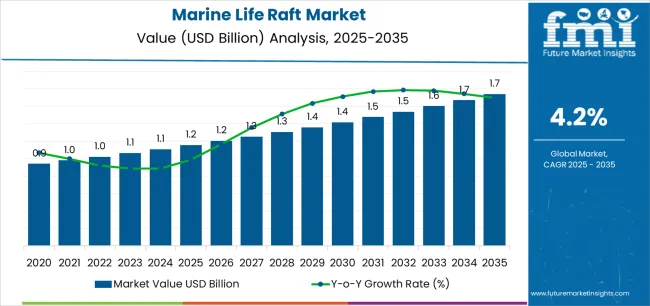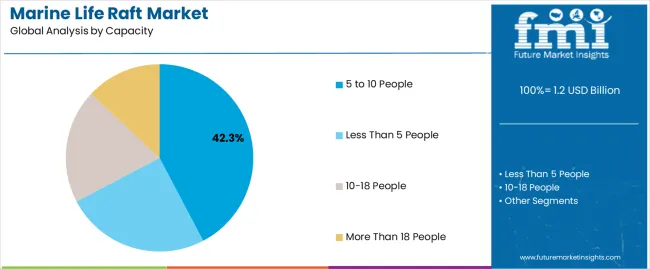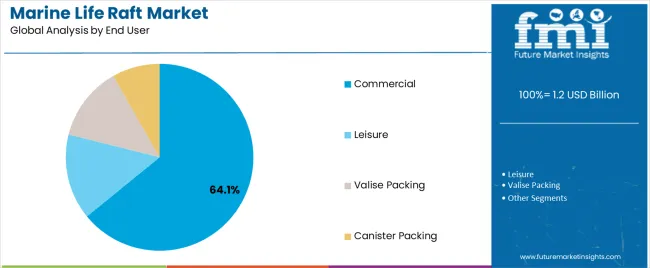The Marine Life Raft Market is estimated to be valued at USD 1.2 billion in 2025 and is projected to reach USD 1.7 billion by 2035, registering a compound annual growth rate (CAGR) of 4.2% over the forecast period.
The marine life raft market is experiencing steady growth driven by increasing maritime trade, expanding offshore activities, and stringent safety regulations mandating life-saving equipment on vessels. Demand is being reinforced by technological advancements in material design, lightweight construction, and rapid deployment systems that enhance reliability and operational readiness. Rising adoption of safety protocols across commercial and defense maritime sectors is further supporting product demand.
Market participants are focusing on product durability, maintenance efficiency, and regulatory compliance to strengthen competitiveness. The future outlook remains positive as global seaborne trade expands and governments emphasize maritime safety standards and crew welfare.
Growth rationale is built upon continuous innovation in inflatable technology, improved storage solutions, and growing replacement cycles driven by safety certifications As awareness of marine safety and international compliance obligations increases, the market is expected to experience consistent expansion across both developed and emerging maritime economies.

| Metric | Value |
|---|---|
| Marine Life Raft Market Estimated Value in (2025 E) | USD 1.2 billion |
| Marine Life Raft Market Forecast Value in (2035 F) | USD 1.7 billion |
| Forecast CAGR (2025 to 2035) | 4.2% |
The market is segmented by Product Type, Capacity, and End User and region. By Product Type, the market is divided into Inflatable (Flexible), Rigid, Single Tube Life Raft, and Multi Tube Life Raft. In terms of Capacity, the market is classified into 5 to 10 People, Less Than 5 People, 10-18 People, and More Than 18 People. Based on End User, the market is segmented into Commercial, Leisure, Valise Packing, and Canister Packing. Regionally, the market is classified into North America, Latin America, Western Europe, Eastern Europe, Balkan & Baltic Countries, Russia & Belarus, Central Asia, East Asia, South Asia & Pacific, and the Middle East & Africa.

The inflatable (flexible) segment, accounting for 58.70% of the product type category, has emerged as the leading segment due to its superior portability, rapid deployment features, and cost efficiency. Its dominance is supported by the ability to be compactly stored and quickly inflated during emergencies, ensuring compliance with international maritime safety regulations.
The use of advanced synthetic materials has enhanced resilience against harsh marine conditions, extending product lifespan and reducing maintenance costs. Demand from commercial and naval vessels has remained robust owing to standardized adoption mandates and increased fleet modernization.
Continued advancements in inflation technology and integration of smart sensors for safety monitoring are expected to reinforce segment growth The combination of lightweight construction and reliability positions inflatable life rafts as the preferred choice for diverse vessel categories across global markets.

The 5 to 10 people capacity segment, representing 42.30% of the capacity category, has maintained its leadership due to widespread suitability for mid-sized commercial and passenger vessels. Its operational flexibility and ease of storage have made it the preferred configuration among ship operators and offshore platforms.
The segment’s prominence is further strengthened by regulatory requirements mandating capacity-specific installations aligned with crew size and vessel type. Manufacturers are focusing on optimizing inflation time, ergonomic seating, and integrated survival equipment to enhance safety and comfort.
The segment continues to benefit from expanding small- and medium-sized vessel operations in tourism, logistics, and coastal patrols Ongoing innovations in material design and compact packaging are expected to sustain market preference for this capacity range, supporting steady adoption across key maritime regions.

The commercial segment, holding 64.10% of the end user category, remains dominant owing to its extensive vessel fleet size and mandatory safety compliance regulations. Growth has been supported by rising demand from cargo shipping, fishing, and passenger transport industries, which rely heavily on certified life-saving equipment.
The segment benefits from large-scale procurement initiatives and frequent replacement cycles mandated by international maritime safety conventions. Continuous fleet expansion and modernization programs across Asia-Pacific and Europe have further accelerated product deployment.
Manufacturers are prioritizing durability, ease of maintenance, and regulatory certification to meet commercial standards and reduce operational downtime With maritime trade volumes projected to grow steadily, the commercial segment is expected to sustain its leadership position and continue driving overall market expansion through consistent global demand.
Marine life rafts demand expanded at a 3.50% CAGR from 2020 to 2025. A wider range of consumers is being reached by marine life raft manufacturers by expanding their distribution networks. Ocean cruise ships, among other types of sea travel, are expected to increase in number. Marine life raft demand is expected to increase due to tighter regulations, increased cruise demand, and certification requirements.
Police rafts are increasingly being deployed to patrol river systems and seas to combat criminal activities. A rigid inflatable raft is suitable for many maritime operations due to its speed, robustness, lightness, and durability. Due to their design and functionality as well as the urgent need to reduce illegal activities, they are highly appealing to consumers.
A healthy growth rate is predicted for the marine life raft market over the forecast period. Sales of inflatable rafts will grow due to the increasing popularity of water-related recreational activities among young adults and millennials. Between 2025 and 2035, the market is expected to increase at a CAGR of 4.40%.
| Historical CAGR from 2020 to 2025 | 3.50% |
|---|---|
| Forecast CAGR from 2025 to 2035 | 4.40% |
The section analyzes the marine life raft market across key countries, including Canada, the United States, the United Kingdom, China, and Japan. The analysis analyzes the factors that contribute to the demand for marine life rafts in these countries.
| Countries | Forecast CAGRs from 2025 to 2035 |
|---|---|
| Canada | 4.70% |
| The United States | 3.40% |
| The United Kingdom | 3.20% |
| China | 3.90% |
| Japan | 5% |
Marine life rafts are becoming an increasingly popular safety gear that ensures crew and passenger safety and complies with maritime laws. Recreational boating, fishing, and commercial shipping are among these activities. The United States is expected to expand at a CAGR of 3.40% between 2025 and 2035.
The popularity of recreational boating in the United States emphasizes the importance of safety gear for recreational activities at sea, which makes marine life rafts very popular among boaters and yacht owners.
With Canada's advances in shipbuilding and marine technology, cutting-edge marine life rafts are being adopted with cutting-edge features and materials, which improve safety standards and comply with maritime laws. Between 2025 and 2035, Canada is predicted to expand at a CAGR of 4.70%.
A booming shipbuilding industry and Canada’s renowned maritime prowess have enabled life rafts made there to become a vital part of ship safety equipment all over the world.
Due to the United Kingdom's strict compliance with maritime safety laws and standards, marine life rafts are more important for emergency evacuations and guarantee regulatory compliance. The United Kingdom will experience a 3.20% CAGR between 2025 and 2035.
With the United Kingdom's focus on coastal defense and search and rescue missions, marine life rafts have become an increasingly important piece of equipment for maintaining maritime safety and security.
Increasing maritime operations and China's rapid economic growth have resulted in the country's need for marine life rafts to safeguard crew members and passengers, owing to its growing economy and international trade. China is expected to exhibit a growth rate of 3.90% during the forecast period.
Through safety awareness and education programs that emphasize the importance of equipping boats with marine life rafts, China's maritime industry is cultivating a culture of safety and readiness.
With Japan's emphasis on maritime safety and adherence to international rules, marine life rafts have become vital safety equipment onboard vessels, making sure vessels meet safety standards and improving emergency preparedness. Over the forecast period, Japan is expected to expand at a CAGR of 5%.
As Japan's fishing fleet ages, it becomes necessary to modernize and upgrade safety equipment, including marine life rafts, to ensure the safety of fishermen and to comply with maritime regulations.
This section illustrates the market's leading segment. The inflatable segment is expected to hold a market share of 64.4% in 2025. More than 18 people segment is expected to experience a market share of 45.5% from 2025 to 2035.
| Category | Market Share in 2025 |
|---|---|
| Inflatable | 64.4% |
| More than 18 People | 45.5% |
Life raft demand can be affected by changes in maritime safety regulations and standards. Ship routing changes, increased maritime activities, or improvements in safety technology can impact life raft demand. The inflatable market is expected to hold a 64.4% market share by 2025.
Businesses may seek to upgrade their safety equipment as a result of innovations, such as new materials, designs, and features, which are driving advances in life raft technology. Companies may prioritize compliance and sustainability as a result of increasing awareness of environmental issues and regulations related to maritime pollution.
The market for marine life rafts is dominated by rafts that can hold more than 18 people. A large number of commercial ships, offshore installations, and larger maritime operations use these rafts.
With high-capacity life rafts, large groups can survive and be safely protected in maritime emergencies under the strictest safety regulations. The market is projected to have a share of 45.5% during the forecast period.
With cutting-edge features like GPS tracking, automatic inflation systems, and complete survival kits, these life rafts provide improved capacities for quick deployment and efficient emergency response, making them essential parts of maritime safety gear for ships operating in a variety of marine environments.

Many large, medium, and small-sized companies are developing, manufacturing, and offering marine life raft services in the international market. New technologies are increasingly being integrated into automobiles by automakers to gain a competitive advantage in the world market.
Key Market Developments
| Attributes | Details |
|---|---|
| Estimated Market Size in 2025 | USD 1,105.53 million |
| Projected Market Valuation in 2035 | USD 1699.68 million |
| Value-based CAGR 2025 to 2035 | 4.40% |
| Forecast Period | 2025 to 2035 |
| Historical Data Available for | 2020 to 2025 |
| Market Analysis | Value in USD million |
| Key Regions Covered | North America; Latin America; Western Europe; Eastern Europe; South Asia and Pacific; East Asia; The Middle East and Africa |
| Key Market Segments Covered | Product Type, Capacity, End User, Region |
| Key Countries Profiled | The United States, Canada, Brazil, Mexico, Germany, United Kingdom, France, Spain, Italy, Poland, Russia, Czech Republic, Romania, India, Bangladesh, Australia, New Zealand, China, Japan, South Korea, GCC countries, South Africa, Israel |
| Key Companies Profiled | Fujikura Composites; VIKING Life; Survitec Group Limited; Zodiac; Brasyech; LALIZAS; Liferaft Systems Australia; MIZUNO MARINE Co. Ltd.; Plastimo; Collins Aerospace; Ovatek Inc. |
The global marine life raft market is estimated to be valued at USD 1.2 billion in 2025.
The market size for the marine life raft market is projected to reach USD 1.7 billion by 2035.
The marine life raft market is expected to grow at a 4.2% CAGR between 2025 and 2035.
The key product types in marine life raft market are inflatable (flexible), rigid, single tube life raft and multi tube life raft.
In terms of capacity, 5 to 10 people segment to command 42.3% share in the marine life raft market in 2025.






Full Research Suite comprises of:
Market outlook & trends analysis
Interviews & case studies
Strategic recommendations
Vendor profiles & capabilities analysis
5-year forecasts
8 regions and 60+ country-level data splits
Market segment data splits
12 months of continuous data updates
DELIVERED AS:
PDF EXCEL ONLINE
Marine Nutraceutical Market Size and Share Forecast Outlook 2025 to 2035
Marine Power Battery System Market Size and Share Forecast Outlook 2025 to 2035
Marine Trenchers Market Size and Share Forecast Outlook 2025 to 2035
Marine Electronics Tester Market Size and Share Forecast Outlook 2025 to 2035
Marine Steering Systems Market Size and Share Forecast Outlook 2025 to 2035
Marine & Dock Gangways Market Size and Share Forecast Outlook 2025 to 2035
Marine HVAC System Market Size and Share Forecast Outlook 2025 to 2035
Marine Outboard Engines Market Size and Share Forecast Outlook 2025 to 2035
Marine Stabilizers Market Size and Share Forecast Outlook 2025 to 2035
Marine Fuel Injection System Market Size and Share Forecast Outlook 2025 to 2035
Marine Energy Market Size and Share Forecast Outlook 2025 to 2035
Marine Propulsion Engine Market Size and Share Forecast Outlook 2025 to 2035
Marine Protein Hydrolysate Market Size and Share Forecast Outlook 2025 to 2035
Marine Fin Stabilizer Market Size and Share Forecast Outlook 2025 to 2035
Marine Extract Market Size and Share Forecast Outlook 2025 to 2035
Marine Squalene Alternatives Market Size and Share Forecast Outlook 2025 to 2035
Marine Prebiotics Market Size and Share Forecast Outlook 2025 to 2035
Marine Collagen-Based Products Market Analysis - Size, Share, and Forecast Outlook 2025 to 2035
Marine Communication Market Size and Share Forecast Outlook 2025 to 2035
Marine Derived Proteins Market Size and Share Forecast Outlook 2025 to 2035

Thank you!
You will receive an email from our Business Development Manager. Please be sure to check your SPAM/JUNK folder too.
Chat With
MaRIA